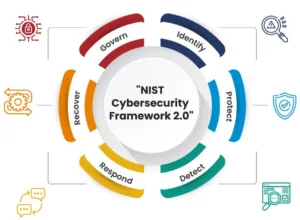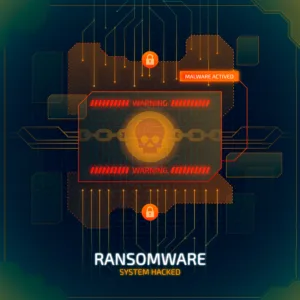
Table of Contents
In this blog post, we will delve deeper into the evolving threats and the strategies that organizations can employ to enhance their cyber resiliency. It’s not enough to build digital fortresses; it’s essential to build adaptive and robust systems that can withstand the storm of ever-evolving cyber threats.
Let’s explore the significance of adapting in the face of these challenges.
I. Introduction
In today’s interconnected digital landscape, the term “cyber resiliency” has become increasingly vital. It refers to an organization’s capacity to not only withstand and recover from cyberattacks but also adapt and evolve in response to the ever-changing threat landscape. As the digital realm evolves, so too do the methods and tactics employed by cyber adversaries. This dynamic environment demands that businesses and institutions alike grasp the concept of cyber resiliency and its role in safeguarding their operations.
Cyber resiliency is more than just a buzzword; it’s a fundamental approach to cybersecurity. It encompasses an organization’s ability to anticipate, prepare for, respond to, and recover from cyber threats and incidents while continuing to function effectively. It goes beyond traditional cybersecurity practices, which often focus on prevention and defense, by recognizing that no system is entirely impenetrable. Instead, it emphasizes adaptability and recovery in the face of adversity.
The digital world is in a state of perpetual transformation. New technologies, vulnerabilities, and opportunities emerge daily, providing fertile ground for cyber threats. Cyber adversaries are quick to exploit these openings, and their methods continue to evolve. From malware and phishing schemes to ransomware attacks and nation-state cyber espionage, the threat landscape is complex, diverse, and unrelenting. It is against this backdrop of constant change that organizations must refine their approach to cybersecurity and embrace the concept of cyber resiliency.
II. The Evolution of Cyber Threats
Cyber threats have come a long way since the early days of the internet. Understanding the historical context, current landscape, and emerging threats is crucial to appreciating the need for adaptive cyber resiliency.
A. Historical Cyber Threats
In the early years of the internet, threats were relatively simplistic compared to today’s standards. They consisted of viruses, worms, and basic malware that could disrupt or damage computer systems. Notable historical cyber threats include the “ILOVEYOU” worm in 2000, the Code Red and Nimda worms in 2001, and the SQL Slammer worm in 2003.
These threats primarily targeted vulnerabilities in software and operating systems, spreading rapidly through networks. Organizations began to recognize the importance of security measures, giving rise to the field of cybersecurity.
B. Present-Day Threats and Trends
The digital landscape has seen a significant shift in recent years, marked by increasingly sophisticated threats. Present-day cyber threats include a broad spectrum of attacks such as:
– Phishing: Deceptive emails and websites that trick individuals into revealing sensitive information.
– Ransomware: Malicious software that encrypts data, demanding a ransom for its release.
– Advanced Persistent Threats (APTs): Long-term, targeted attacks by skilled adversaries, often with geopolitical motives.
– Data breaches: Unauthorized access to sensitive data, leading to privacy and security concerns.
– Supply chain attacks: Targeting third-party vendors to infiltrate an organization’s systems.
The current threat landscape is characterized by more complex, financially motivated, and politically driven attacks. It is essential for organizations to stay updated on these threats and adapt their cybersecurity strategies accordingly.
C. Emerging Threats (e.g., AI-driven attacks, IoT vulnerabilities)
Looking ahead, emerging threats are on the horizon, posing new challenges for cyber resiliency. Some of these include:
– AI-driven attacks: AI and machine learning can be harnessed by cybercriminals to automate attacks, making them more efficient and evasive.
– IoT vulnerabilities: The proliferation of Internet of Things (IoT) devices increases the attack surface, with inadequate security measures leaving them susceptible to exploitation.
– 5G-related risks: The rollout of 5G networks introduces new potential attack vectors and increased connectivity.
As technology advances, the threats evolve in tandem. To enhance cyber resiliency, organizations must anticipate and prepare for these emerging challenges. In the following sections, we will explore strategies to adapt and respond effectively to this evolving threat landscape.
III. The Importance of Adapting
In the face of evolving cyber threats, the importance of adapting your approach to cybersecurity cannot be overstated. Traditional methods often fall short in addressing the dynamic nature of modern threats, making adaptive cyber resiliency a necessity.
A. Why Traditional Approaches Fall Short
Traditional cybersecurity approaches are built on the foundation of perimeter defense, focusing on preventing threats from entering the network.
While this approach is essential, it has limitations:
– Assumption of invulnerability: Traditional methods assume that if the perimeter is secure, the organization is safe. However, this assumption doesn’t account for insider threats, zero-day vulnerabilities, or sophisticated attacks that may already be within the network.
– Lack of agility: Fixed security measures can’t quickly adapt to new and unforeseen threats. They may be effective against known threats, but they struggle to defend against emerging attack vectors.
– Focus on prevention over response: Traditional approaches emphasize prevention but may not prioritize incident response and recovery, leaving organizations vulnerable when a breach does occur.
B. Case Studies of Organizations Affected by Inflexibility
Real-world examples illustrate the consequences of an inflexible cybersecurity approach. High-profile breaches of organizations like Equifax, Target, and Sony have demonstrated the severe impact of insufficient adaptation to evolving threats. These cases highlight how failing to adapt to emerging threats and vulnerabilities can result in financial losses, damage to reputation, and legal consequences.
C. The Need for Adaptive Cyber Resiliency
The need for adaptive cyber resiliency arises from the recognition that no system can be entirely impervious to cyber threats. An adaptive approach acknowledges the inevitability of breaches and focuses on resilience, recovery, and continuous improvement. Key aspects of this need include:
– Acceptance of risk: Organizations should acknowledge that cybersecurity is about managing risk, not eliminating it. This paradigm shift leads to a more adaptive mindset.
– Prioritizing response and recovery: Preparing for incidents and having robust response plans in place is just as vital as prevention. It ensures a swift recovery and minimizes damage.
– Continuous improvement: Cyber resiliency is an ongoing process that involves learning from incidents and adapting to new threats. Organizations should regularly assess and update their security measures.
Adaptive cyber resiliency not only strengthens an organization’s defenses but also ensures its ability to withstand, respond to, and rebound from the inevitable cyber incidents that occur in today’s ever-changing threat landscape. In the following sections, we will explore strategies to implement an adaptive cyber resiliency framework.
IV. Key Strategies for Adapting to Evolving Threats
To enhance cyber resiliency and adapt to evolving threats, organizations must employ a combination of strategic approaches. These key strategies provide a solid foundation for adapting to the ever-changing cyber landscape.
A. Continuous Monitoring and Threat Intelligence
Continuous monitoring of your IT infrastructure and staying informed about emerging threats through threat intelligence are crucial components of adaptive cyber resiliency. This includes:
– Real-time monitoring: Utilize advanced monitoring tools to track network activity and system behavior, identifying anomalies that may indicate a breach.
– Threat intelligence feeds: Stay updated on the latest threat information and indicators of compromise (IOCs) to proactively defend against known threats.
– Vulnerability assessment: Regularly assess and patch vulnerabilities in your systems to reduce the attack surface.
B. Agile Incident Response Plans
An agile incident response plan is essential for swift and effective action when a security breach occurs. It involves:
– Preparation: Develop well-defined incident response procedures, including roles and responsibilities for team members.
– Detection: Implement intrusion detection systems to identify threats early in the attack lifecycle.
– Containment and eradication: Act promptly to isolate and remove threats from your network.
– Communication: Ensure clear and timely communication with stakeholders, both internal and external.
– Lessons learned: Conduct post-incident reviews to learn from each incident and improve response procedures.
C. Employee Training and Awareness
Your employees are often the first line of defense against cyber threats. Comprehensive training and awareness programs are vital:
– Security training: Educate employees on safe online practices, recognizing phishing attempts, and protecting sensitive data.
– Regular awareness campaigns: Keep cybersecurity at the forefront of employees’ minds with ongoing awareness initiatives.
– Social engineering exercises: Conduct simulated phishing or social engineering attacks to test employee responses and provide additional training.
D. Third-Party Risk Management
Many organizations rely on third-party vendors and services, making third-party risk management critical:
– Vendor assessments: Regularly evaluate the cybersecurity practices of your vendors and partners.
– Contractual requirements: Establish security expectations in contracts and service-level agreements.
– Continuous monitoring: Keep tabs on the security practices of third parties to ensure they meet your standards.
E. Technology Stack Optimization
Your technology stack should be agile and well-suited to evolving threats:
– Cloud security: If you’re using cloud services, ensure robust cloud security measures and access controls.
– Endpoint protection: Employ advanced endpoint security solutions to protect individual devices.
– Zero-trust architecture: Implement a zero-trust model that verifies and authenticates all users and devices, even those within your network.
– Security automation: Utilize automation and AI to improve threat detection and response.
These strategies, when integrated into your cybersecurity approach, help build a strong foundation for adapting to and mitigating evolving cyber threats. In the following sections, we will explore the practical implementation of an adaptive cyber resiliency framework.
V. Implementing an Adaptive Cyber Resiliency Framework
Adapting to evolving cyber threats requires a well-structured framework within your organization. This framework should encompass various key elements to ensure a proactive and resilient response to changing threat landscapes.
A. Building a Cross-Functional Resiliency Team
To effectively implement an adaptive cyber resiliency framework, it’s essential to establish a cross-functional resiliency team. This team should include members from different departments and expertise areas, such as:
– IT and cybersecurity professionals: To manage and respond to technical aspects of security incidents.
– Legal and compliance experts: To navigate legal and regulatory implications of breaches.
– Communications and PR specialists: To manage public relations and communications during and after an incident.
– Business continuity experts: To ensure that core business functions can continue during disruptions.
– Risk management professionals: To assess and mitigate potential risks.
This cross-functional team ensures a well-rounded and comprehensive approach to handling cyber threats.
B. Establishing Clear Communication Protocols
Effective communication is a cornerstone of any adaptive cyber resiliency framework. Establishing clear communication protocols is crucial:
– Incident reporting: Implement a well-defined process for employees to report security incidents promptly and securely.
– Internal communication: Develop communication channels and guidelines for disseminating information within the organization, ensuring that all relevant stakeholders are informed.
– External communication: Define procedures for communicating with external parties, including customers, partners, regulatory bodies, and the public, while maintaining transparency and managing reputational risks.
– Crisis communication plan: Prepare a plan that outlines how the organization will communicate in the event of a major security incident, specifying who is responsible for what and providing templates for communication materials.
C. Regular Drills and Simulations
Regular drills and simulations are essential to test and refine your incident response procedures:
– Tabletop exercises: Conduct simulated scenarios where team members discuss their responses to a theoretical cyber incident.
– Penetration testing: Regularly assess your organization’s security posture through controlled penetration tests to identify vulnerabilities and weaknesses.
– Incident response drills: Simulate real incidents to test the effectiveness of your response plans and identify areas for improvement.
Regular practice ensures that your team is well-prepared and can adapt quickly when a real threat emerges.
D. Monitoring and Feedback Loops
Continuous monitoring of your security measures and feedback loops are critical for adapting to new threats:
– Security analytics: Leverage data analytics and monitoring tools to identify patterns and anomalies that may indicate evolving threats.
– Incident post-mortems: After each incident, conduct detailed post-mortem analysis to understand what went right, what went wrong, and what needs improvement.
– Feedback integration: Use the insights gained from post-mortems and monitoring to adjust and improve your cybersecurity measures.
Implementing these components within your adaptive cyber resiliency framework ensures that your organization is prepared to adapt to evolving threats and effectively respond to incidents while constantly improving your security posture.
VI. Measuring the Effectiveness of Adaptation
Ensuring that your adaptive cyber resiliency framework is effective is as important as its implementation. To do this, you need to measure the impact of your efforts and continuously strive for improvement.
A. Metrics and KPIs for Cyber Resiliency
Measuring the effectiveness of your adaptive cyber resiliency practices requires the establishment of clear metrics and Key Performance Indicators (KPIs). Here are some relevant metrics to consider:
– Mean Time to Detect (MTTD): The average time it takes to detect a security incident, from its initiation to discovery.
– Mean Time to Respond (MTTR): The average time it takes to respond to and mitigate an incident once it’s detected.
– Number of incidents: Keeping track of the frequency and types of security incidents.
– Percentage of incidents contained: Measuring how often incidents are effectively contained before they cause significant damage.
– Recovery time: How long it takes to return to normal operations after an incident.
– User awareness improvement: Measuring the progress of employee training and awareness in recognizing and reporting security threats.
– Cost of incidents: Calculating the financial impact of security incidents, including direct and indirect costs.
Regularly evaluating these metrics allows you to assess the effectiveness of your adaptive resiliency measures and make data-driven improvements.
B. Continuous Improvement and Iteration
Adaptive cyber resiliency is an ongoing process, and you should be committed to continuous improvement and iteration. This involves:
– Learning from incidents: After each security incident, conduct thorough post-mortems to identify what worked well and where improvements are needed.
– Adjusting your framework: Use the lessons learned to refine your incident response plans, training programs, and security measures.
– Staying informed: Stay updated on the latest threats and best practices in cybersecurity and incorporate this knowledge into your framework.
– Regular testing: Continuously assess and test your security measures, adapting them to address new risks.
– Employee feedback: Solicit feedback from employees regarding training and security protocols, and use this input to enhance your approach.
By fostering a culture of continuous improvement and iteration, your organization can adapt to evolving threats effectively, ensuring that you remain resilient in the face of an ever-changing cybersecurity landscape.
VII. Future Trends in Cyber Resiliency
As the cyber threat landscape continues to evolve, it’s crucial to anticipate upcoming challenges and leverage technological innovations to enhance cyber resiliency.
A. Predictions for Upcoming Threats and Challenges
The future of cyber resiliency will be shaped by emerging threats and challenges. Here are some predictions:
– AI-driven attacks: Expect an increase in the use of artificial intelligence and machine learning by cybercriminals to automate and enhance attacks.
– Quantum computing: The advent of quantum computers may render current encryption methods obsolete, necessitating new approaches to secure data.
– 5G-related risks: As 5G networks become more widespread, anticipate new vulnerabilities and potential attack vectors.
– Supply chain complexity: With the growing complexity of supply chains, organizations will face increased risk from third-party vulnerabilities.
– IoT security: The Internet of Things (IoT) will continue to expand, requiring robust security measures to protect interconnected devices.
– Regulatory changes: Keep an eye on evolving data privacy regulations and compliance requirements, which will impact how organizations handle data and respond to incidents.
Anticipating these trends allows organizations to proactively adapt their cyber resiliency strategies.
B. Technological Innovations in Resiliency
Technological advancements play a pivotal role in enhancing cyber resiliency. Keep an eye on innovations in the following areas:
– Artificial intelligence and machine learning: AI can be leveraged for threat detection, behavioral analysis, and automation in incident response.
– Blockchain technology: Blockchain can enhance data integrity and authentication, reducing the risk of data tampering.
– Zero-trust security models: Implementing zero-trust architecture, which assumes no trust within or outside the network, can bolster security.
– Security orchestration and automation: Automation of routine security tasks can free up human resources for more complex threat analysis and response.
– Cloud-native security: With the increasing use of cloud services, security tools and practices need to be tailored for cloud-native environments.
– Cybersecurity analytics: Advanced analytics tools can provide deeper insights into potential threats and vulnerabilities.
Keeping up with technological innovations and staying ahead of emerging threats is essential for organizations aiming to maintain a high level of cyber resiliency in the future. Adaptation is an ongoing process that necessitates a proactive approach to security.
VIII. Conclusion
In an era of ever-evolving cyber threats, the importance of adaptive cyber resiliency cannot be overstated. The dynamic nature of the digital landscape demands that organizations be prepared not only to withstand and recover from cyberattacks but also to adapt and evolve in response to the changing threat landscape.
A. The Necessity of Adaptive Cyber Resiliency
Adaptive cyber resiliency is more than a security strategy; it’s a mindset shift. It recognizes that no system is invulnerable and that cyber threats will continue to evolve. It acknowledges the inevitability of breaches and emphasizes the need for preparation, response, and continuous improvement. By embracing adaptive cyber resiliency, organizations position themselves to navigate the complex and ever-changing cybersecurity landscape effectively.
B. Encouragement to Stay Informed and Continuously Adapt
In conclusion, we encourage organizations to remain vigilant, stay informed, and continuously adapt to the challenges of the digital world. Cyber resiliency is not a one-time effort but an ongoing journey. By staying updated on emerging threats, leveraging technological innovations, and fostering a culture of continuous improvement, organizations can thrive in the face of cyber adversity.
Remember that in the realm of cybersecurity, adaptation is not a luxury but a necessity. By implementing the strategies discussed in this blog post and remaining agile in your approach, you can build a robust defense against evolving cyber threats and ensure your organization’s cyber resiliency for the future.
Read more on https://cybertechworld.co.in for insightful cybersecurity related content.




















Hi, I have a website in a similar area as you. Is it ok if I ran some of these tools on this website at https://twitter.com/SoManySeoTools/status/1719315727511904618/1698987144? I thought I’d be polite and ask first. I’m trying to expand my presence on the web.
Ok
Your article helped me a lot, is there any more related content? Thanks!